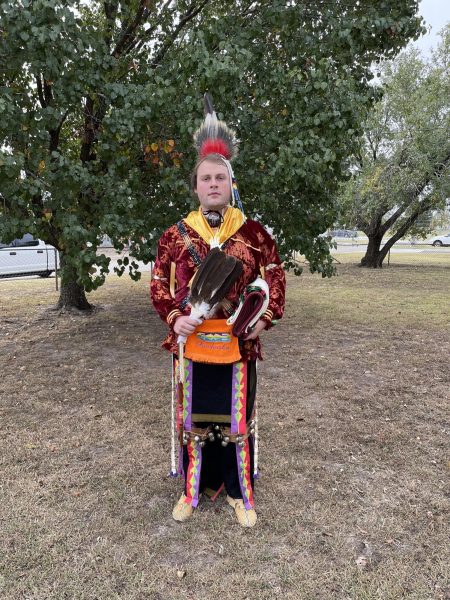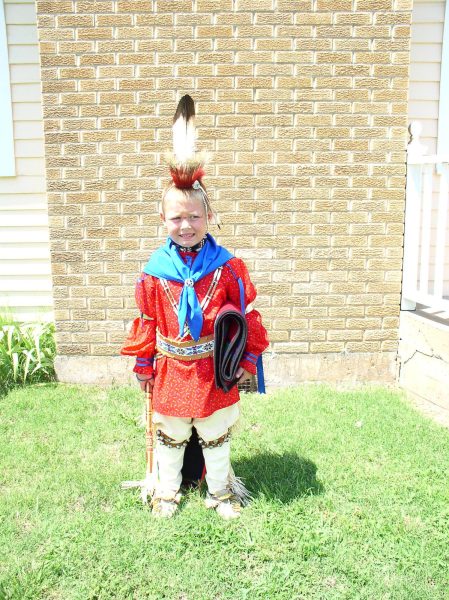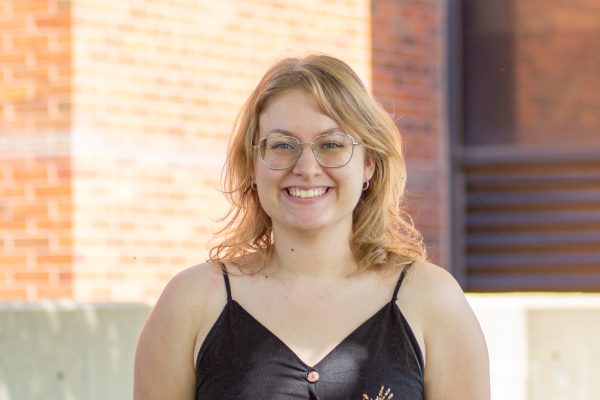
From plastic tubs and engraved wooden chests, Aaron Valentine unpacks the precious pieces of regalia passed down by his ancestors — soft leather moccasins, intricately beaded bandoliers and a heart-shaped neckerchief buckle. Every once and a while, Valentine will haul these containers to campus for the viewing and educational pleasure of Wichita State students.
When Aaron can’t transport his traditional clothing, like when Chelsea Redger-Marquardt’s class traveled to the Grand Canyon, he instead shares a treasure trove of knowledge, taught to him through years of cultural retellings and countless hours of research.
Osage Nation
For as long as he can remember, Valentine has been surrounded by Osage and American customs and traditions.
“I always thought, when I was little, that everyone … would go to their own respective places and do the same thing,” Valentine said. “It wasn’t until middle school, you start like sharing your summer plans with others, and people are like, ‘What do you mean you’re going to go dance?’”

Valentine is a member of the Osage, or Wazhazhe, nation. The ancestral territory of the Osage spans across the Midwest, from Oklahoma to Ohio. The current-day Osage reservation sits just along the northern border of Oklahoma, roughly a two-hour drive from Wichita.
Within this territory, four Osage towns, or districts, call the region home: Pawhuska, Hominy, Fairfax and Gray Horse.
Every year, Valentine and his immediate family travel to their district, Pawhuska, to participate in In-lon-schka, a month-long ceremonial gathering of singing, drumming and dancing. During In-lon-schka, Osage men participate in traditional dances, like the Southern Straight, twice a day — once in the afternoon and once at night.
Priceless: Osage traditions and crafts
As a member of the Osage Nation, Valentine annually dons his traditional ensemble to participate in In-lon-schka. Most, if not all, of the elements of his regalia have been passed down for generations. These inherited items are invaluable to Osage tribal members, who are often honored to represent their heritage and culture.
“It’s things that you can’t really put a price on,” Valentine said. “We’d never sell it or give it away because it’s something that ties us not only to our Osage culture but also ties us to one of our ancestors.”
In In-lon-schka ceremonies, dancers make their way counterclockwise around the drum. To go around the drum in the regalia of an ancestor is to honor them while carrying on their legacy. The passed-down items are also significant in keeping the memories, or spirits, of passed loved ones alive.
“When you go around that drum, it’s carrying that person with you,” Valentine said. “It’s a great honor to be able to get something from someone because it shows you they care for you. And it shows a lot about what they think about you at the same time.”
When these items no longer fit or must be stored away for preservation, Valentine says that a member of the Osage community skilled in traditional bead, leather or yarn work can craft new regalia items. After outgrowing a set of streamers, a prominent element of Osage attire, Valentine enlisted the help of his grandmother to craft his own set.
“And so (like) a lot of things, they take a lot of time to make … it generally tends to eat up a lot of your time,” Valentine said. “She’s like, ‘I’ll help you do it, but you’re going to do the majority of it and sit down and do the hard stuff.’”
Valentine and Osage education today
Learning traditional crafts isn’t the only way Valentine works to keep his, and other native cultures, alive and known. As an employee of the Cohen Honors College, Valentine has been called upon to speak on Native American cultures in several classes, including Kevin Harrison’s “Black Lives Matter and Other Marginalized Perspectives” and Redger-Marquardt’s “Parks, People and Place: Exploring Our National Parks.”
“I did a little bit of co-facilitation on how indigenous voices within Zion (National Park), kind of related to the Paiute … and how showing people that Native Americans and First Nations cultures and things like that are still very prevalent,” Valentine said. “It’s not something that’s a thing of the past.”
National parks have historically been established without regard for Native American peoples, who often inhabited and used the land for survival and spiritual purposes. Valentine often discusses with students the conflicting elements of how those parks are “revered for being natural wonders,” but those who inhabited the land before were considered anything but.
“If that didn’t fit in with the European way of how people viewed how nature should be, they’re (Native American peoples) basically removed for it,” Valentine said.
Valentine is also an active co-facilitator in the Honors College’s BILL’S Trip, a service-learning experience that takes students to national parks nationwide to learn about leadership, stewardship and partnership. In January, Valentine accompanied Redger-Marquardt and 30 honors students to the Grand Canyon, where Valentine was instrumental in planning and teaching students about the native cultures of the area.
From handling the contracts for the charter buses to learning about and speaking on the tribes originally native to national parks, Redger-Marquardt said Valentine has “just ran with it,” putting his all into every aspect of the program.
She said that Valentine’s insight helps students appreciate and be respectful of these lands that others used to call home.
“We could have you read about it … or we could have you learn from someone that is such a fantastic representative of the Osage Nation and learn that in real-time,” Redger-Marquardt said.
At a broader scale, Valentine hopes his perspective and teaching will help students build critical thinking skills and establish open conversations when making impactful decisions.
“It’s important to kind of have this dialogue between the two to really get to a solution that’s … not just beneficial for one side or the other,” Valentine said.
Valentine will graduate this May with a master’s degree in engineering management. When he walks to accept his diploma, he’ll proudly display his Osage Nation cord and wear some of his great-grandfather’s ribbon work. While he doesn’t know yet what he’ll pursue professionally, he hopes to use his Native American culture to promote unity and acceptance.
“It’s not like we’re living a completely different life,” Valentine said. “So while there’s certain aspects that may be completely different from how you live it regionally, we kind of live similar.”




Joseph Abbott • Mar 18, 2024 at 5:05 pm
If Mr Valitines district is Pawhuska . Where does his linage come from ? What Osage families? Grandparents, Greatgrandparents ?